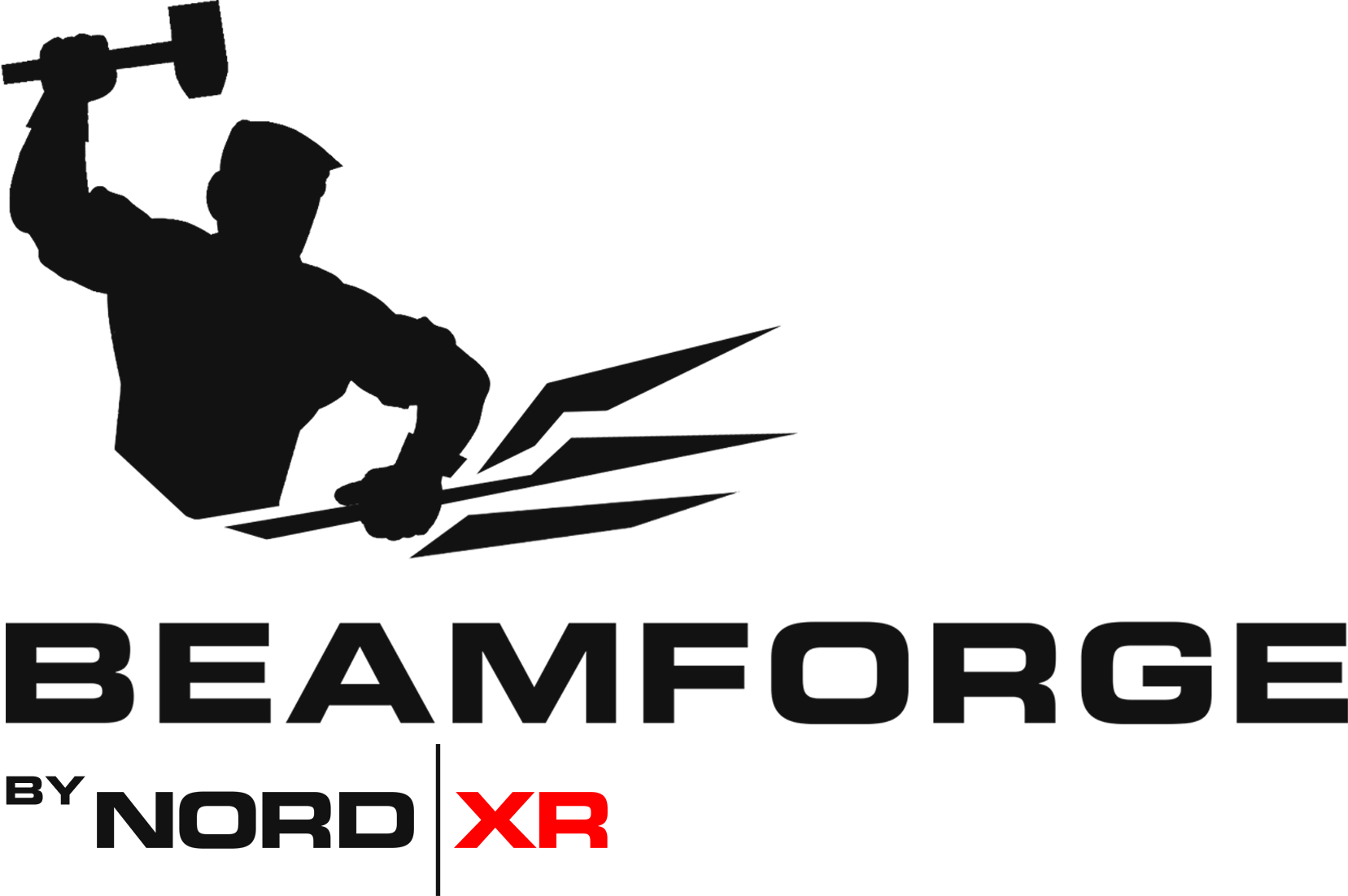
VU/R
ABSTRACT
XR (Extended Reality), real-time CGI and BIM (Building Information Modeling) are becoming increasingly important in the planning and marketing of projected real estate. Interested parties can view, appraise and configure a desired development long before construction begins, equip their ideas accordingly and experience them comprehensively (light, sense of space and surface area, etc.). The future of real estate is in XR.
We develop Augmented and Virtual Reality experiences with BEAMFORGE, our proprietary XR SDK, which we have been continually developing and expanding since 2018.
As an UNREAL ENGINE based, multi-platform framework for XR configurators, interactive experiences and simulations, BEAMFORGE has everything you’ll ever need for immersive product communication.
All the more annoying when architects, engineers and graphic artists have to overcome unnecessary technical hurdles, set by e.g. arbitrary format specifications, when creating demanding real-time visualizations.
This is where VU/R kicks in, to boost the workflow between Revit/BIM planning and professional real-time visualization. VU/R not only overcomes technical hurdles, but is also a planning assistance system and configurator for construction projects and maximizes the added value of real-time visualization right from the planning phase.
“Once a new technology rolls over you, if you’re not part of the steamroller, you’re part of the road.”
STEWART BRAND
1 THE CLAIM
If you aim for the highest standards when projecting, planning and designing construction projects, you will not accept compromises when it comes to real-time visualizations. Autodesk Revit is establishing itself as the industry standard for project design and construction. But as intriguing and diverse as the technical possibilities of the program collection are, so are Autodesk’s attempts at Virtual Reality and real-time visualization in their infancy.
Anyone wishing to switch to professional real-time rendering and VR tools will be disappointed as Autodesk only allows direct export of Revit data to their own tools, such as Stingray or Revit Live, but the achieved visual quality and performance are not comparable to established 3D engines.
The Unreal Engine, which represents the current industry standard in real-time rendering, originally comes from the gaming field and has been continuously developed for more than 20 years with the goal of implementing real-time visualization as efficiently and credibly as possible. The following videos illustrate the high standard of these engines.
1.1 UNREAL REAL-TIME RENDERING
Fed with the right data and used by skilled artists, the current iteration of the Unreal Engine achieves almost photo-realistic visual results. It really pushed the envelope with real-time raytracing and complex light calculations, plus a complex, automated level-of-detail (LOD) handling, dubbed Nanite. Here’s an example of three environments, all rendered and captured in real-time with Unreal Engine:
2 THE PROBLEM
2.1 INCOMPATIBILITY
The world of 3D development and modeling programs is split into two camps: one, mainly represented by Autodesk’s Revit and AutoCAD, focuses on engineering and design of construction projects, while the other focuses on high-quality, real-time visualization ( 3D Engines like Unity or Unreal).
Both have obvious weaknesses in each other’s strengths, or a deliberately different focus, which is why 3D designers and planners basically use different programs for planning and visualization. For example, Autodesk Revit for designing and Epics Unreal for visual presentation of the object.
However, an essential problem here is that Autodesk has provided for the direct export and exploitation of holistic Revit data only for in-house programs and there are no compatible formats or interfaces for direct exchange with external, powerful real-time visualization tools. In the usual way, Revit data can be converted to DXF format via third-party software such as Blender or 3D-Studio MAX and can be laboriously manually corrected, but a significant amount of relevant data is lost or corrupted. The following video shows the process of manually converting an object created in Revit to Unreal in practice. Pay attention to how advanced the building is in Revit and how little of it ends up in the visualization engine:
Much of the data is currently non-transferable or lost during manual conversion. These must be completely recreated by the 3D graphics artist in the visualization engine. Due to these incompatibilities and the expense of manual conversion, high-quality real-time visualizations are often developed only to demonstrate either complete planning or presentation of initial designs. However, they play a minor role during the planning and development process.
Autodesk is slowing down the development of Virtual Reality by limiting native-format data to proprietary formats, as their tools are clearly inferior to the industry standards of real-time visualization in terms of performance and credible presentation. The free usability of the data is deliberately curtailed.
2.2 EFFORT
Another obstacle in the development of high-quality real-time visualizations during the planning and development process is the high effort that has to be made to make projected real estate look real. In addition to complex material assignments, light and shadow settings, the environment is brought to life with all kinds of accessories: plants, furniture, pictures, lamps, etc. are placed to make the visualization believable. In the following video you can see how a 3D graphics artist furnishes an apartment.
If one were to use this effort for each intermediate acceptance of planning sections, all the premises would have to be manually converted, illuminated and equipped from scratch after the implementation of every small change in Autodesk’s Revit.
2.3 LACK OF FLEXIBILITY
Visualizations and virtual reality demonstrations are usually static: in classical presentations, they are individual images or films, and real-time visualizations allow one to move around freely, but the interaction with content remains the exception. Changes to the virtual environment can only be made by the 3D graphics designer himself.
It would be useful if you as a viewer basic things directly in the presentation, or could change. What kind of parquet? Oak? Dark or bright? Or maybe larch nature? Which wall color? Which curtains? What does the table look like in a different color?
Such functions would not only make sense in the equipment planning, but also in sales to end customers who can set their preferred equipment options during the virtual reality inspection of a projected property.
3 THE VISION
High-quality virtual reality and real-time demonstrations should be created by planners autonomously, or even without external service providers, without artificial limits through file formats and with intelligent systems of assisstance. These visualizations should be parametrized beyond the pure building data, be detailed and configurable and allow viewers to interact with them, or to configure the demonstrated real estate. Subsequent changes to the structural structure should assume already created configurations, so that no further detailing or adaptation of the equipment is necessary.
To do this, all relevant data from Revit must be automatically interchangeable between the visualization engine and Revit without manual reworking and data loss, the equipment and detailing must be parametrizable and in the generated visualization or virtual reality demonstration should be predefined features such as colors, materials etc. be dynamically configurable.
4 THE PROJECT
The name VU/R not only aims at wordplay with the English term viewer, but with its syntax also on VR, or “VU/R” for “View/Revit”, to make clear that it is about more than an assistance system for classic visualizations. VU/R is particularly useful for the easy creation of Virtual Reality demonstrations from real estate projected in Autodesk Revit. In fact, it makes no difference whether the end product is a slide show or a headset-accessible virtual reality demonstration. Like the problem, the project is divided into three tasks:
4.1 DATA TRANSFER AND COMPATIBILITY
The problem of data incompatibility between Revit and Unreal can be addressed on several fronts. Plugins for Unreal (Open Source), Revit or an external converter that extracts relevant information from BIM files (BIM: Building Information Modeling, a complex file format from Revit) or even a combination of measures. A library with unreal engine materials to be defined would also be obvious, which includes respective equivalents to standard Revit materials, so that new materials do not have to be created with each transfer. But as the topic is also addressed in detail: The goal is a direct import or transfer capability of Revit data.
4.2 AUTOMATED DETAILING & EQUIPMENT
When it comes to equipment and especially when furnishing real estate, there are no limits to creativity. In any case, we think so. In reality, the placement of furnishings is governed by laws that can be derived from the spatial conditions and the average size of a person and are therefore parametrizable.
These are as obvious things as furniture does not float in the air (note in the video above how much time the graphic designer spends placing objects correctly on the floor), but above all, a multitude of subtler influences ,
For example, sofas are always up to a certain room size on the wall with the seat directed to the center of the room, in front of a coffee table at an average distance of 50 cm to the seat edge of the sofa. The room size also gives e.g. the size and position of a dining table. The size of the dining table again determines how many chairs are around it. Pictures are ideally hung on the wall so that their center is 150 cm above the ground, etc.
All these rules can be parameterized in such a way that a planner would just have to define what kind of property (office, residential property, etc.) and room (bedroom, living room, etc.) it is, so that VU/R generates a procedurally generated one Facility can suggest. The entire process of equipping the property (as shown in the video above) would be done in seconds.
The parameterization can also be extended to the environment of a property. The planner only indicates the time of day, the type of environment (urban, rural, forest, etc.) and VU / R automatically suggests a corresponding background for the scene.
4.3 INTERACTIVITY & DYNAMICS
Any virtual reality demonstration and real-time visualization of real estate should provide the opportunity to make configuration or equipment changes to the considered property. This allows planners, but also end customers, to decide directly which equipment, colors and materials fit.
For this purpose, a user interface must be developed within the framework of the project, which allows the configuration to be as intuitive and comfortable as possible.
5 CONCLUSION
New possibilities for thousands of 3D developers: VU/R breaks the boundaries between the industry standards of 3D planning and 3D real-time visualization. The ability to swap all relevant data between standards allows people who previously designed objects in Unreal or Unity to switch to Revit for their designs, and Revit users previously limited to Stingray or Revit Live for real-time visualization of their objects. Unreal and Unity use.
Furthermore, VU/R allows real estate planners to create virtual reality demonstrations based on their Revit data without necessarily involving external visualization service providers. All relevant features are already combined in VU/R: The parameterizability allows purpose-specific equipping and detailing of objects at the highest level.
In the course of the parameterization, the 3D planner can also determine the details to be configured by the viewer (parquet, fittings, colors, materials, etc.) and thus develop high-quality virtual reality or real-time presentations from Revit-projected construction projects within minutes eg can be used in the distribution of objects.



